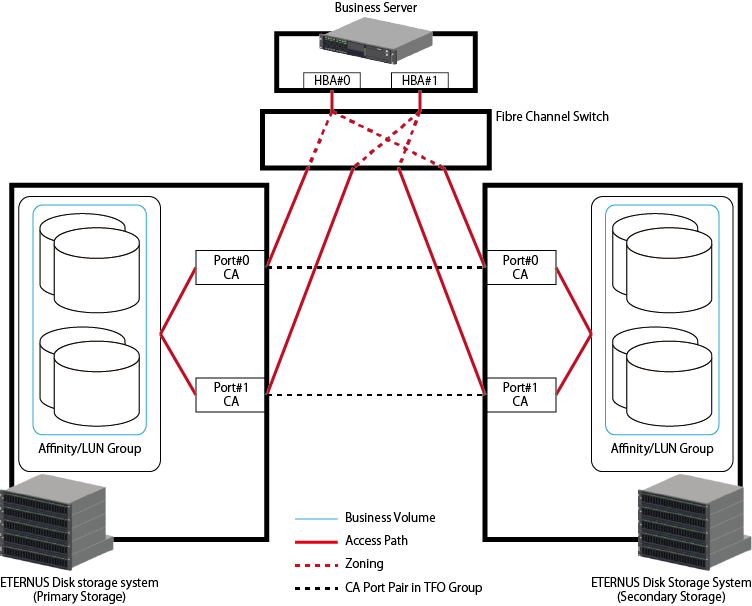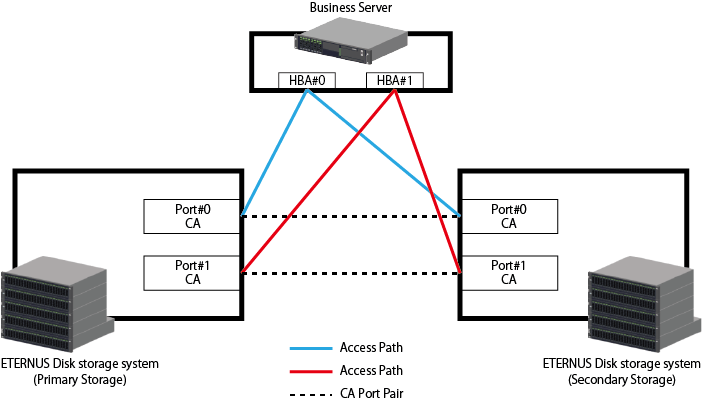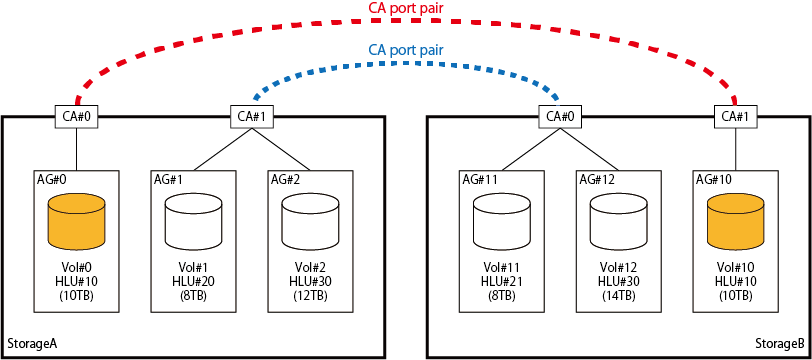Allocating Business Volume
Start or change operation of the Storage Cluster function in the following steps:
The example of structure regarding allocation of business volumes is shown in "Figure 9.12 Storage Cluster Function: Structure Example of Allocating Business Volume".
Figure 9.12 Storage Cluster Function: Structure Example of Allocating Business Volume

Prepare volumes to be switched in the Storage Cluster function. Perform this operation on Primary and Secondary ETERNUS Disk storage systems respectively.
The volumes to be switched by Storage Cluster must meet all of the following requirements:
There should be volumes of the same size in respective Primary and Secondary ETERNUS Disk storage systems.
Volume type is any of "Standard", "WSV", "TPV" or "FTV".
And the volume type of corresponding volumes on Primary Storage and Secondary Storage should be the same.
"SDV" and "SDPV" are not supported. "FTV" can use the Storage Cluster function. However, after failover/failback, the performance information required for operation of Automated Storage Tiering and relocation status by Automated Storage Tiering is not inherited.
Advanced Copy should not be in operation.
See
Refer to "Create Volume" or "Create FTV" in the ETERNUS SF Web Console Guide to create a new volume.
If there is no space in RAID group, Thin Provisioning pool or Tier pool, refer to "Operations for RAID Group", "Operations for Thin Provisioning" or "Operations for Automated Storage Tiering" in the ETERNUS SF Web Console Guide to secure areas.
When using the volumes already allocated to servers for the Storage Cluster function, create volumes in an ETERNUS Disk storage system as Secondary Storage so that the above requirements are met.
In addition, if Advanced Copy is in operation, stop it.
See
To stop Advanced Copy, refer to either of the following sites in accordance with the function in use:
When the Copy Control Module function of AdvancedCopy Manager is in use:
Refer to "Operations Started from Storage Tab" in the ETERNUS SF Web Console Guide.
When the backup operation or replication operation of AdvancedCopy Manager is in use:
Refer to "Operations Started from Server Tab" - "Operations for Advanced Copy" in the ETERNUS SF Web Console Guide.
Connect the volumes to be switched by Storage Cluster function to servers. Perform this operation on Primary and Secondary ETERNUS Disk storage systems respectively.
The following operations are required to configure access paths:
Create Affinity / LUN group.
Configure Host Affinity (Associate server HBA, port on disk storage system and Affinity/LUN group)
Configure FC switch zoning.
It is recommended to use the volume allocation function to configure access paths that can perform the above operations all at one time and configure multiple access paths between a certain server and a certain ETERNUS Disk storage system at the same time.
See
Refer to "Assign ETERNUS Disk Storage System Volumes to Server" in the ETERNUS SF Web Console Guide for the procedure to allocate volumes.
Configure access path in the following steps:
About selection of server HBA and port on ETERNUS Disk storage system
Associate the two ports specified as a pair in TFO Groups with the same HBA.
For example, if HBA and ports are selected as shown in "Figure 9.13 Storage Cluster Function: Example of Correct Access Path Configuration", the Storage Cluster function is available.
Figure 9.13 Storage Cluster Function: Example of Correct Access Path Configuration

If HBA and ports are selected as shown in "Figure 9.14 Storage Cluster Function: Example of Incorrect Access Path Configuration", the Storage Cluster function is not available.
Figure 9.14 Storage Cluster Function: Example of Incorrect Access Path Configuration

About creation of Affinity/LUN group
Storage Cluster function enabled volumes must be defined to Affinity/LUN group based on the following rules:
The size of corresponding volumes on Primary Storage and Secondary Storage specified for the same LUN No. (HLU) is the same.
Volume type is any of "Standard", "WSV", "TPV" or "FTV". And the volume type of corresponding volumes on Primary Storage and Secondary Storage is the same.
Note
If access path configuration does not meet the requirements, error occurs on the device side and the operation log is displayed. Refer to the ETERNUS SF Message Guide for corrective actions,
When access paths are configured to Primary and Secondary ETERNUS Disk storage systems, the volumes start to be synchronized by the Storage Cluster function.
Take the following steps to see whether specified volumes are properly configured as Storage Cluster function enabled volumes:
Click Storage on the global navigation tab.
Registered ETERNUS Disk storage systems are displayed on the Main pane.
On the Main pane, click the Name of a target ETERNUS Disk storage system.
On the Category pane, click Volume.
Created volumes are displayed on the Main pane. If a string of "/TFOV" is included in the value displayed in the Usage column, the volume is properly configured as a Storage Cluster enabled volume.
It takes a certain period of time for access paths to be configured and volumes to be synchronized so that failover is enabled. To see whether synchronization is completed and failover is executable, continue to perform Step 4.
On the Category pane, click Storage Cluster.
The items on the Category pane switch to those associated with Storage Cluster and created TFO Groups are displayed on the Main pane.
If the value in the Phase column for TFO Group is "Normal", all the volumes in the TFO Group are synchronized and ready to be available for failover.
When using Automated Failover, check the following points, too:
Failover Mode of TFO Group is "Auto", and
Phase of TFO Group is "Normal", and
Status of TFO Group is "Normal".
Note
In host affinity groups under a pair of CA ports, the volumes that have the same HLU number and capacity can be a synchronized pair. Match those volumes with the same HLU number and capacity.
In volume synchronization, an initial copy is done between paired volumes. The time required for initial copy is affected by line speed of transfer, quality, data compression ratio (depending on data contents), being greatly varied.
An indication of time required is as follows:
Requirements for Initial Copy | Time needed |
|---|---|
FC-RA port and IP network: one line (1Gbit/sec) connection, Typical throughput of FC switch: 114MB/sec (=114,000,000byte/sec) (data compression ratio 50%, no delay) | 1.5 hrs |
FC-RA port and IP network: one line (100Mbit/sec) connection, Typical throughput of FC switch: 12MB/sec(12,000,000byte/sec) (data compression ratio 50%, no delay) | 13 hrs |
iSCSI-RA port and IP network: one line (1Gbit/sec) connection, Typical throughput of iSCSI-RA port: 26MB/sec (no data compression, 30msec delayed) | 12 hrs |
Figure 9.15 Storage Cluster Function: Example of Synchronized Volumes

The above figure represents the following matters:
A pair of Vol#0 of Storage A and Vol#10 of Storage B is the same in HLU number and size, so that they are synchronized (failover enabled) volumes.
A pair of Vol#1 of Storage A and Vol#11 of Storage B is different in HLU number, so that they cannot be synchronized.
A pair of Vol#2 of Storage A and Vol#12 of Storage B is different in size, so that they cannot be synchronized.
Trying to make a pair of CA ports correlated to the volumes that are the same in HLU number but different in size terminates the processing abnormally.
Refer to "Status of TFO Group" for the status of TFO Group.
Updating TFO Group Status
The status of TFO Group is not automatically updated except when Reload Configuration is executed for a target ETERNUS Disk storage system. In the following cases, update and check the status of TFO Group:
Add or delete a business volume.
Execute Manual Failover, Manual Failback or Force-Failover.
Any failure detected in TFO Group, port, volume or REC Path used for Storage Cluster is notified by SNMP trap.
Update the status in the following steps:
Click Storage on the global navigation tab.
Registered ETERNUS Disk storage systems are displayed on the Main pane.
On the Main pane, click the Name of a target ETERNUS Disk storage system.
On the Category pane, click Storage Cluster.
The items on the Category pane switch to those associated with Storage Cluster and created TFO Groups are displayed on the Main pane.
On the Action pane, click Update under TFO Group Status.
A dialog box is displayed. Click Done.
When this operation is performed, the TFO status of the other device paired with the selected device is also updated.
Note
If communication is disabled between paired devices, the operation terminates abnormally with error status. Even in this case, the selected device is updated.
Refer to "Status of TFO Group" for the status of TFO Group.
Adding and Deleting Business Volume
When changing any Storage Cluster function enabled volume, delete it or add a volume or do both. Specifically, Affinity/LUN groups must be changed for Primary and Secondary ETERNUS Disk storage systems. The procedure to see which Affinity/LUN group to change is as follows:
Click Storage on the global navigation tab.
Registered ETERNUS Disk storage systems are displayed on the Main pane.
On the Main pane, click the Name of a target ETERNUS Disk storage system.
On the Category pane, click Connectivity.
The items on the Category pane switch to those associated with Connectivity.
On the Category pane, click Host Affinity.
A list of host affinities is displayed on the Main pane.
Check in the Port column, host affinity including ports specified as pairs in TFO Groups. The Affinity/LUN group configured to the host affinity must be changed.
See
Refer to "Change Affinity/LUN Group Settings" in the ETERNUS SF Web Console Guide for the procedure to change Affinity/LUN group.
After changing, it takes a certain period of time for volumes to be synchronized and failover to be enabled.
Refer to "Confirming Configuration" in "Allocating Business Volume" for the procedure to see if synchronization is completed and failover is executable.
Note
There is an upper limit to the number of volumes that can be defined to one Affinity/LUN group. Refer to the manual for the ETERNUS Disk storage system in use for the upper limit.
The capacity expansion and format of Storage Cluster function enabled volumes are not supported.
Manual Failover/Failback
If Storage Cluster Controller is placed and Automated Failover is set when configuring TFO Groups, any failure in ETERNUS Disk storage systems are detected and failover is automatically performed. In the case the Storage Cluster Controller is not placed or switchover is needed right now for switching test, failover can be done manually. When performing Failover manually, Normal mode and Forced mode can be selected. Refer to "Force-Failover" for Forced mode.
On completion of recovery of Primary ETERNUS Disk storage system, perform failback operation manually.
The following is the procedure to perform failover/failback manually:
Click Storage on the global navigation tab.
Registered ETERNUS Disk storage systems are displayed on the Main pane.
On the Main pane, click the Name of a target ETERNUS Disk storage system.
For Manual Failover, select Primary ETERNUS Disk storage system and for Manual Failback, select Secondary ETERNUS Disk storage system.
On the Category pane, click Storage Cluster.
The items on the Category pane switch to those associated with Storage Cluster and created TFO Groups are displayed on the Main pane.
On the Main pane, select a TFO Group for which you want to enable failover or failback and click Failover or Failback on the Action pane.
A warning dialog box is displayed.
When enabling failover or failback, click OK.
Point
If Primary ETERNUS Disk storage system is down or removed and communication is not enabled with that storage system, Manual Failover is not possible. Make sure that Primary disk storage system is stopped to execute Force-Failover.
Force-Failover
Execute Force-Failover only when Primary ETERNUS Disk storage system is down or removed and becomes inaccessible from business servers.
Click Storage on the global navigation tab.
Registered ETERNUS Disk storage systems are displayed on the Main pane.
On the Main pane, click the Name of a target ETERNUS Disk storage system.
Select a Primary ETERNUS Disk storage system.
On the Category pane, click Storage Cluster.
The items on the Category pane switch to those associated with Storage Cluster and created TFO Groups are displayed on the Main pane.
On the Main pane, select a TFO Group for which you want to enable Force-Failover and click Force-Failover on the Action pane.
A warning dialog box is displayed.
When executing Force-Failover, click OK.
Note
If the ETERNUS Disk storage system as Primary Storage is connected to business servers, do not execute this function.
If this function is executed, the ETERNUS Disk storage system as Secondary Storage checks the status of the Primary ETERNUS Disk storage system and tries to do secure failover. However, if the status cannot be checked, the Secondary ETERNUS Disk storage system is forced to be active.
At this stage, if the Primary ETERNUS Disk storage system is connected to servers, both Primary and Secondary Storage systems are caused to be active, possibly leading to data corruption due to overlapped WWPN/WWNN.
Status of TFO Group
Each status of TFO Group has the following meaning:
This displays whether the disk storage is connected to the server (active side) or not connected to the server (standby side).
Status | Meaning |
|---|---|
Active | Indicates that the disk storage is currently connected to a server (active side). |
Standby | Indicates that the disk storage is not connected to a server (standby side). |
Unknown (*1) | Trouble with network is causing status update to fail. |
*1: "Unknown" has a meaning common to all the statuses, so is omitted hereinafter.
This displays the status of TFO Group. It varies with the configuration of TFO Groups, operation of failover/failback and state of volume synchronization.
Status | Meaning |
|---|---|
Initial | Indicates that TFO Group is configured but no volume is allocated. |
Maintenance | Indicates that copy sessions between TFO port pairs and volumes are forcibly cleared. |
Copying | Indicates that volumes are being synchronized from Primary Storage to Secondary Storage. |
Normal | Indicates that volume synchronization is completed and failover is ready to be done. |
Failovered | Indicates the status immediately after failover is completed. Update after a while. |
Copying Back | Indicates that after recovery of Primary Storage, volumes are being synchronized from Secondary Storage to Primary Storage. |
Failback Ready | Indicates that after recovery of Primary Storage, volume synchronization is completed and failback is ready to be done. |
Failbacked | Indicates the status immediately after failback is completed. Update after a while. |
Failed | Indicates the status other than those above. This phase may be temporarily displayed in sequences of failover and failback. Update after a while. |
This displays whether TFO Group status is normal or error.
Status | Meaning |
|---|---|
Halt | Indicates that there is a fault in TFO Group. Refer to "Halt Factor" to take action. |
Normal | Indicates that TFO Group is in normal status. |
If there is any error in TFO Group, its cause is displayed.
Status | Meaning |
|---|---|
None | Indicates that TFO Group is in normal status. No action is required. |
TFO Group Disconnected | Indicates that the path to a destination device is blocked or the device is not started. |
Version Mismatch | Indicates that a destination device does not support Storage Cluster function or the firmware version does not support Storage Cluster. If the firmware is not up-to-date, update the firmware. |
TFO Group Setting Missing | TFO Group settings of a destination device are not found. |
TFO Group Setting Mismatch | Indicates that data transfer of Storage Cluster is disabled at all the RA ports of Secondary Storage or there are some inconsistencies in TFO Group settings at a destination device. Take either of the following actions:
|
Monitoring Server Disconnected | Indicates that the path to Storage Cluster Controller is blocked or Storage Cluster Controller is not started. This status is displayed only when Storage Cluster Controller is set up. Take either of the following actions:
|
Note
When any status other than those above is displayed, perform the following operations:
After a while, perform "Updating TFO Group Status".
Refer to "9.4.1 Installation" and "9.4.2 Operation" to review the settings or reconfigure.
If the problem is not solved, record the displayed status to contact Fujitsu Technical Support.